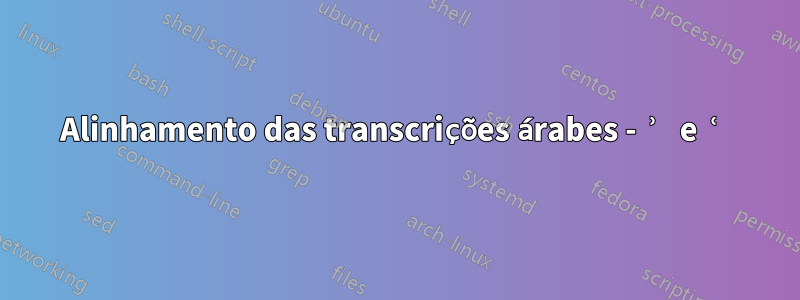
Ao compor exemplos linguísticos com transcrições das letras árabeshamzaeayn, ʾ e ʿ respectivamente, o alinhamento com a tradução literal na linha abaixo parece estranho. Veja exemplo (1). Isso também vale para listas e ambientes tabulares. O alinhamento na Tabela 1 não é bom.
Uma maneira de remediar isso é empurrar \llap{ʾ}esse caractere para a esquerda e alinhar a palavra com o segundo caractere. Isso fornece o exemplo (2) e a Tabela 2, muito mais bonitos (na minha opinião).
Agora vamos à minha pergunta. Existe uma maneira de automatizar isso? Quero que dois caracteres, ʾ e ʿ, se tornem \llap{ʾ}e \llap{ʿ}quando precedidos por um espaço (e se possível também pelo caractere de tabulação) em determinados ambientes, principalmente example. Esta solução funcionaria para tabelas adicionando um espaço antes dos itens, como no código da Tabela 1. Acho que seria possível ativar esses caracteres. (Pelo que entendi é possível ativar caracteres Unicode no XeLaTeX, que é o que estou usando.) Eu sei sobre \@ifnextchar, mas o que seria necessário aqui é algo como \@ifprevchar.
EDITAR: preciso de uma solução na qual eu possa colocar palavras individuais na transcrição do exemplo em ambientes, por exemplo \textbf{}.
\documentclass{article}
\usepackage{fontspec}
%\usepackage[utf8]{inputenc}
\usepackage{array}
\usepackage{covington}
\begin{document}
\begin{example}
\gll bi-lātīk ʾanā ʾaktub ʾaḥla nuṣūṣ
with-latex I write prittyest texts
\glt `With \LaTeX{} I can write the prettiest texts.'
\glend
\end{example}
\begin{example}
\gll bi-lātīk \llap{ʾ}anā \llap{ʾ}aktub \llap{ʾ}aḥla nuṣūṣ
with-latex I write prittyest texts
\glt `With \LaTeX{} I can write the prettiest texts.'
\glend
\end{example}
\begin{table}[h!]
\centering
\caption{Ugly alignment}
\begin{tabular}{>{\itshape}ll}
ʾanna & comp.\\
ʾinna & `verily'\\
lākinna & `but'\\
laʿalla & `perhaps'\\
layta & `if only'\\
\end{tabular}
\end{table}
\begin{table}[h!]
\centering
\caption{Nice alignment}
\begin{tabular}{>{\itshape}ll}
\llap{ʾ}anna & comp.\\
\llap{ʾ}inna & `verily'\\
lākinna & `but'\\
laʿalla & `perhaps'\\
layta & `if only'\\
\end{tabular}
\end{table}
\end{document}

Responder1
Não é fácil, mas factível, pelo menos para tabulare exampleou examples. Observe como você deve especificar a alteração da fonte na tabela de colunas.
\documentclass{article}
\usepackage{fontspec}
\usepackage{etoolbox,array,collcell}
\usepackage{covington}
\makeatletter
\newrobustcmd{\checkforstart}{%
\@ifnextchar ʾ{\llap}{\checkforayn}%
}
\newcommand{\checkforayn}{%
\@ifnextchar ʿ{\llap}{}%
}
\makeatother
\newcolumntype{H}[1]{>{#1\collectcell\docheckforstart}l<{\endcollectcell}}
\newcommand{\docheckforstart}[1]{\checkforstart #1}
\begin{document}
%%%%%%%%%%%%%%%%%%%%%%%%%%%%%
%%% For technical reasons this can't go in the preamble, sorry
\catcode`\^^M=12
\patchcmd{\getwords}{\strut}{\strut\checkforstart}{}{}%
\catcode`\^^M=5
%%%%%%%%%%%%%%%%%%%%%%%%%%%%%
\begin{example}
\gll bi-lātīk ʾanā ʾaktub ʾaḥla nuṣūṣ ʿTEST
with-latex I write prittyest texts TEST
\glt `With \LaTeX{} I can write the prettiest texts.'
\glend
\end{example}
\begin{example}
\gll bi-lātīk \llap{ʾ}anā \llap{ʾ}aktub \llap{ʾ}aḥla nuṣūṣ ʿTEST
with-latex I write prittyest texts TEST
\glt `With \LaTeX{} I can write the prettiest texts.'
\glend
\end{example}
\begin{tabular}{H{\itshape} l}
ʾanna & comp.\\
ʾinna & `verily'\\
lākinna & `but'\\
laʿalla & `perhaps'\\
layta & `if only'\\
\end{tabular}
\end{document}



